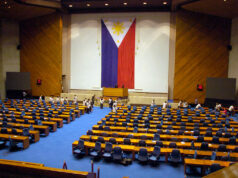BSP leaves policy rates untouched
THE Bangko Sentral ng Pilipinas (BSP) on Thursday kept rates unchanged on expectations of steady inflation and economic growth, and as it monitors the impact of recent monetary adjustments.
The central bank’s policy-setting Monetary Board (MB) left the interest rate on the BSP’s overnight reverse repurchase (RRP) facility untouched at 4.5%, it announced after its review on Thursday. The interest rates on the overnight lending and deposit facilities were likewise held steady at five percent and four percent, respectively.
Six out of the 10 economists polled by BusinessWorld earlier this week expected the central bank to hold fire.
“The Monetary Board believes that the manageable inflation outlook and firm domestic growth prospects support keeping monetary policy settings steady for the time being,” BSP Governor Benjamin E. Diokno said in a briefing.
The BSP chief said latest baseline forecasts show inflation is likely to remain within the 2-4% target range for this year and 2020, although the prolonged El Niño phenomenon continues to be an upside risk.
Headline inflation accelerated in May following six consecutive months of slowdown, settling at 3.2% last month, up from the three percent in April but still slower than the 4.6% recorded in May 2018. Year to date, inflation averaged 3.6%, past the midpoint of the BSP’s target.
Economic growth in the coming months is likewise expected to recover after first quarter’s slowdown, “supported by a projected recovery in household spending and the continued implementation of the government’s infrastructure spending program,” Mr. Diokno said.
Gross domestic product (GDP) grew by 5.6% in the first quarter, its worst performance in four years. This was lower than the 6.3% pace in the preceding quarter and 6.5% in the first quarter of 2018, as well as the downward revised 6-7% target of the government for the year.
“A prudent pause allows the BSP to observe and assess the impact of prior monetary adjustments including the phased reduction in the reserve requirements to be completed by the end of July,” Mr. Diokno added.
At its meeting last May 9, the MB cut key rates by 25 basis points. The BSP also reduced the reserve requirement ratios (RRR) of lenders by a percentage point effective May 31 to 17% for universal and commercial banks, 7% for thrift banks, and 4% for rural and cooperative banks. The reserve ratios of big banks and thrift lenders will be reduced further to settle at 16% and 6%, respectively, on June 28 and July 29.
BSP Deputy Governor Diwa G. Guinigundo said in the same briefing that these RRR reductions are expected to unleash a total of P200 billion into the financial system once the phased implementation is completed.
INFLATION FORECASTS CUT
The BSP sees inflation slowing further this year and in 2020 on the back of likely lower global oil prices and the peso’s appreciation.
Mr. Guinigundo said the central bank revised its inflation forecasts to 2.7% from the 2.9% expected in May for this year and to 3% from 3.1% for 2020.
“For 2019, we expect the peso to be around P52.01 and for 2020, some appreciation to P51.50,” Mr. Guinigundo said.
The official said the forecasts were reduced as price increases remain manageable despite May’s slight uptick. Inflation expectations are also “beginning to be more well-anchored,” he said.
“Growth continues to be resilient and robust,” Mr. Guinigundo added, noting that the policy easing done by the central bank last month serves as a “cushion” and a “preemptive action” against uncertainties.
“There is room for easing monetary policy because the view on inflation is quite optimistic, that it’s going to continue to be moderate,” Mr. Guinigundo said. “But…we need to show and establish the firmness of the downtrend of inflation down the road.”
Nicholas Antonio T. Mapa, senior economist of ING Bank N.V.-Manila branch, said the BSP is likely waiting for further data to assess economic conditions and the impact of the global trade war on the country.
“The next policy meeting (August 8) coincides with the release of 2Q GDP growth, which should by all indications be an improvement from the 1Q print with the economy benefiting from the recent round of policy easing (RRP and RRR cuts) with the fiscal support also seen to boost growth momentum after being sidelined for most of the year,” Mr. Mapa said.
Michael L. Ricafort, head of the economics research division of Rizal Commercial Banking Corp., said policy makers are also awaiting the US Federal Reserve’s next move after it opened the door to more cuts in the coming months at its June 18-19 meeting.
“We likewise expect RRR cuts to be on hold in the meantime as the full effect of the tranches have yet to be felt,” said Security Bank Corp. Chief Economist Robert Dan J. Roces. — R. J. N. Ignacio



